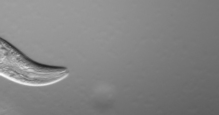
Crawling C. elegans. Goldstein lab, http://labs.bio.unc.edu/Goldstein/movies.html
This is the message that developmental biologist Jeff Hardin tries to get across to his students. Hardin constantly sees beauty in his work, so I thought I would spend some time explaining what he does.
One of the best tools for studying development is the tiny roundworm C.elegans, which must be one of the most studied organisms in the world. Adult humans have around 30 trillion cells in their bodies, but human development is so complex and our bodies are so large and vary so much in size, that estimates vary from 10 to 100 trillion. C.elegans, on the other hand, is a relatively simple organism with about 1,000 cells.
One of the most striking (and useful) things about C. elegans is the ‘invariant lineage’ of its cells. As the embryo grows, development proceeds along a minutely prescribed pattern. A cell in the growing embryo replicates its DNA and divides in two. The ‘daughter cell’ will now follow instructions, either keeping the character of its parent or developing a new trait to form part of a different tissue. Each new cell has its fate mapped out in advance, so there is no room for teenage rebellion among the cells of the C. elegans embryo.
The other useful thing about this worm is its complete transparency, which has allowed biologists to trace the lineage of all 959 of its cells*, including the 131 cells that died along the way.
The life of a small organism can be completely prescribed: hatch, grow, moult four times, then mate. Most C. elegans adults are hermaphrodites – they make sperm, then switch to making eggs, and fertilise themselves. One could find this cycle depressing, but that’s not the take-home message for Hardin.
Biologists always seem to find their chosen organism beautiful, perhaps because they have come to appreciate its features in great detail. It certainly helps if you find beautiful the thing that you spend most of your days staring at. Being able to understand an organism in such detail is beautiful in itself. And the elegance of an animal that is so tiny and yet so detailed is astonishing. Long gone are the days when cells were thought to be homogenous, gelatinous blobs.
The world we inhabit is highly ordered and that order brings complexity. Creatures in some way make themselves, and reproduction is the best example of our being granted some part in the creative process. Even if we don’t completely understand the details, we get to ‘make’ whole new living things – worms on a Petri dish, geranium cuttings, kittens, children…
* Excluding the gametes, which have variable cell numbers If you want to know more about C. elegans, you can read to your heart’s content in this online text book, http://www.wormbook.org, to which Jeff Hardin has contributed a chapter on epidermal morphogenesis.
(Previous series with Jeff: Part 1 here, part 2 here, part 3 here.)




